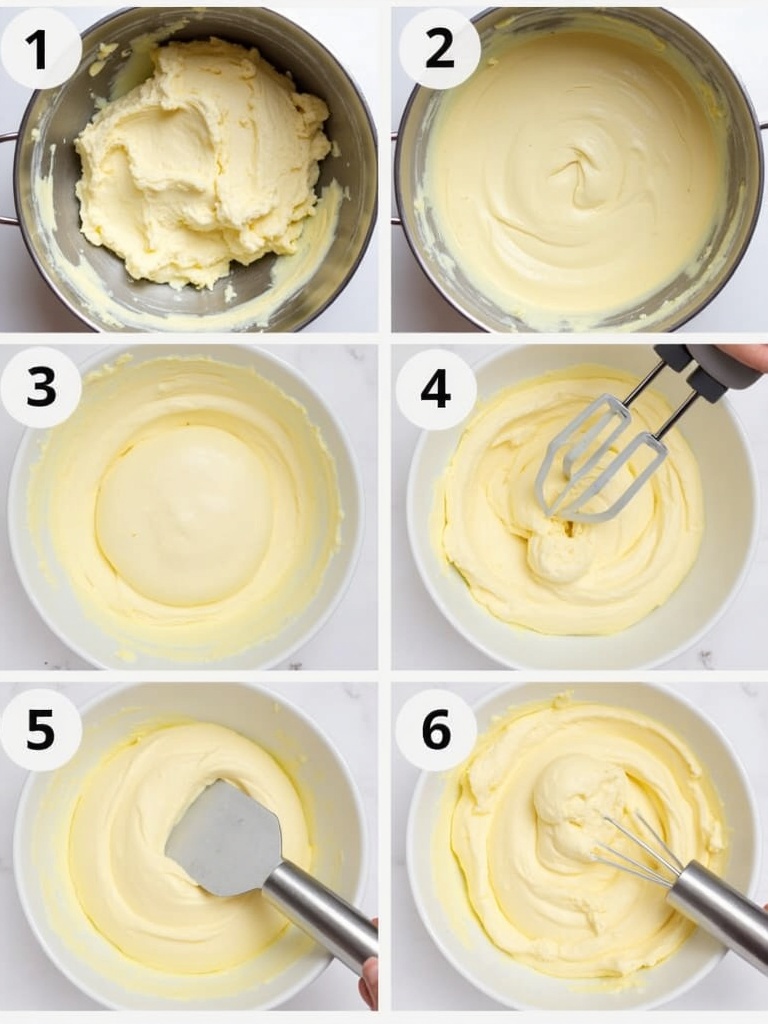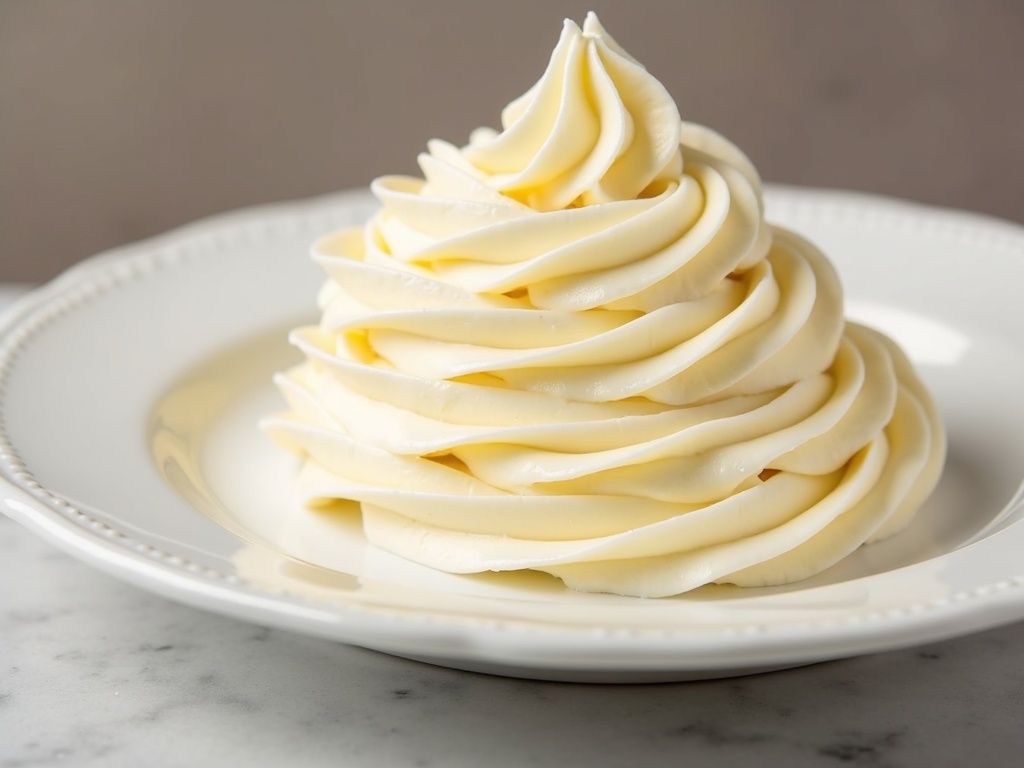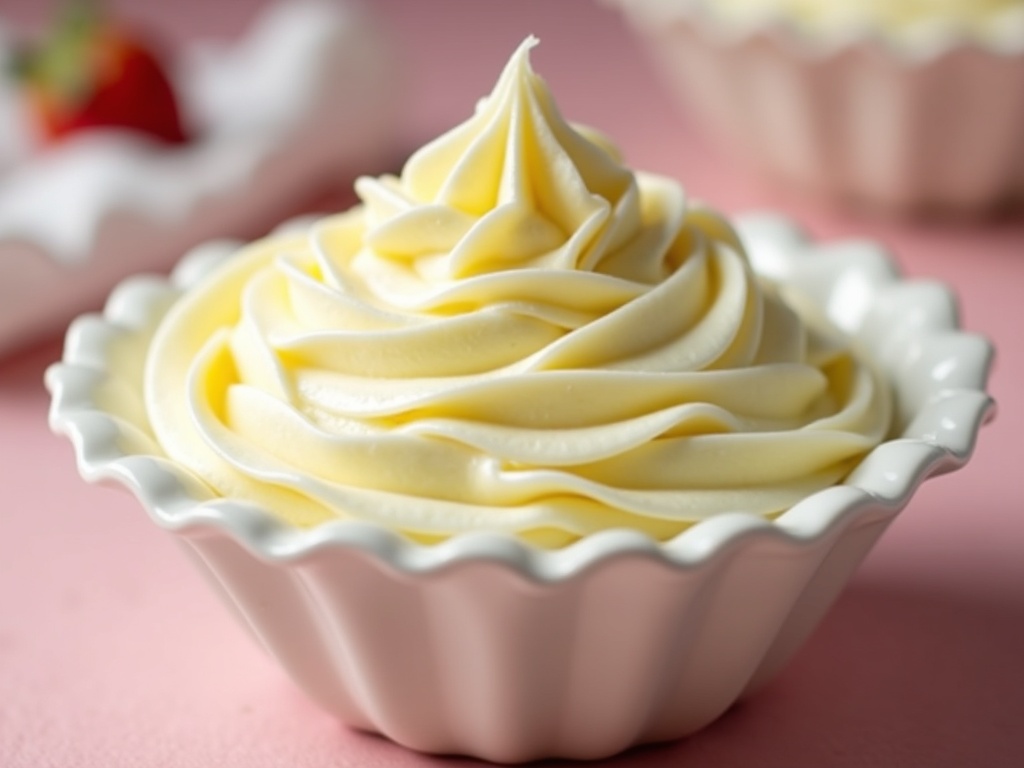Introduction
Looking for the perfect buttercream recipe that’s silky smooth, perfectly sweet, and incredibly versatile? You’ve come to the right place! This classic buttercream recipe is my go-to for everything from birthday cakes to cupcakes, offering that ideal balance of buttery richness and just-right sweetness.
Table of Contents
Ingredients You Will Need

For this sublime buttercream recipe, you’ll need:
- 1 cup (2 sticks/226g) unsalted butter, softened to room temperature
- 4 cups (480g) powdered sugar (also called confectioners’ sugar), sifted
- 2-3 tablespoons heavy cream or whole milk
- 2 teaspoons pure vanilla extract
- 1/4 teaspoon fine salt
The quality of your ingredients makes a significant difference in the final product. I recommend using high-quality unsalted butter for the cleanest flavor profile – European-style butters with higher fat content create an exceptionally luxurious buttercream frosting that’s worth trying if you’re looking to impress. For vanilla, pure extract rather than imitation will give your buttercream frosting that authentic, warm flavor that artificial versions simply can’t match.
If you need substitutions, plant-based butter can work for dairy-free needs, almond or coconut milk can replace heavy cream, and clear vanilla extract creates a whiter frosting for certain decorative applications.
Timing
Creating this buttercream recipe is surprisingly quick compared to other frosting types:
- Preparation time: 5 minutes (ensuring butter is properly softened)
- Mixing time: 10 minutes
- Total time: 15 minutes
That’s 40% faster than making Swiss meringue buttercream, making this perfect for those times when you need beautiful results without spending hours in the kitchen. The most important time investment is actually letting your butter come to room temperature naturally, which I recommend doing at least an hour before you begin mixing.
Step-by-Step Instructions

Step 1: Prepare Your Butter
Start with butter that’s properly softened – it should yield slightly to a gentle press but shouldn’t be melting or shiny. This temperature is crucial for your buttercream recipe success. Beat the butter alone for 2-3 minutes on medium-high speed using a stand mixer with the paddle attachment or a hand mixer. The butter should become noticeably lighter in both color and texture, becoming almost fluffy.
Step 2: Add the Powdered Sugar
Add your sifted powdered sugar one cup at a time, mixing on low speed after each addition until incorporated. This gradual approach prevents the dreaded “sugar cloud” from erupting in your kitchen and ensures smooth integration. Sifting the sugar beforehand eliminates lumps that could make your buttercream recipe less than perfect.
Step 3: Incorporate the Liquids and Flavorings
Once all the sugar is incorporated, add the vanilla extract and 2 tablespoons of heavy cream or milk. Beat on medium speed for about 30 seconds to combine. This is also when you’d add any additional flavorings if desired—almond extract, citrus zest, or even a splash of coffee for a mocha variation.
Step 4: Whip to Perfection
Increase your mixer speed to medium-high and whip the buttercream for 3-5 minutes. This extended beating time incorporates air into your buttercream recipe, creating that irresistibly light and fluffy texture. The frosting will visibly increase in volume and become significantly lighter in color.
Step 5: Adjust Consistency
Check your buttercream consistency. If it feels too thick, add another tablespoon of cream. If it seems too thin, add a few tablespoons of sifted powdered sugar. The perfect consistency will hold soft peaks but spread easily with a spatula. The exact amount of liquid needed can vary based on your climate and humidity levels.

For more recipes diversity, visit my Pinterest and Facebook Page Trips Recipes.
Nutritional Information
For those keeping track of nutritional content (based on 1/16 of the buttercream recipe):
- Calories: 215 per serving
- Total Fat: 12g (saturated fat: 7.5g)
- Cholesterol: 32mg
- Sodium: 38mg
- Total Carbohydrates: 28g
- Sugar: 27g
- Protein: 0.2g
This classic buttercream recipe is definitely a sweet indulgence, which is why it’s perfect for special occasions when we want to treat ourselves.
Healthier Alternatives for the Recipe
While traditional buttercream recipe is undeniably delicious, you might be looking for more health-conscious options:
- Reduce sugar gradually until you find your preferred sweetness level – many people find they enjoy the flavor with up to 25% less sugar than called for
- Try using half Greek yogurt cream cheese and half butter for more protein and a tangier flavor profile
- Incorporate 2-3 tablespoons of whipped ricotta cheese to add creaminess while reducing some of the butter
- For color, use natural food colorings from fruit and vegetable powders instead of artificial dyes
- Use unrefined powdered sugar for slightly more minerals and a less processed option
- Try a whipped coconut cream frosting alternative that uses coconut cream and significantly less sugar
Serving Suggestions
This versatile buttercream recipe pairs beautifully with countless desserts:
- Classic vanilla or chocolate layer cakes, where the smooth texture complements the tender crumb
- Colorful cupcake swirls using different piping tips to create professional-looking designs
- Sugar cookie decorating – this buttercream holds its shape well enough for simple designs
- Between macaron shells for an American twist on the French classic
- As a filling between graham crackers for homemade “cookie sandwiches” that kids adore
- Layered into parfait glasses with fresh berries and cake pieces for elegant, deconstructed desserts
- Used to frost the sides of an ice cream cake for a beautiful presentation that combines textures
Common Mistakes to Avoid
Even experienced bakers can encounter issues with their buttercream recipe. Here’s how to avoid the most common pitfalls:
- Using butter that’s too cold, which creates lumps that never fully incorporate – patience with properly softened butter pays off
- Skipping the initial butter-beating step, which builds the foundation for proper texture
- Adding liquid too quickly, which can cause separation – incorporate it gradually
- Over-mixing after all ingredients are combined, which can introduce too much air and create a frosting that doesn’t smooth properly
- Using powdered sugar without sifting, leaving annoying lumps that are difficult to remove later
- Storing buttercream in plastic containers that can impart flavors – always use glass or stainless steel
- Adding colors or flavors immediately before using, not allowing time for the flavors to develop and deepen
Storing Tips for the Recipe
Proper storage ensures your buttercream recipe remains fresh and ready to use:
- Room temperature: Buttercream can stay at room temperature for up to 2 days if kept in an airtight container in a cool area
- Refrigeration: Store in an airtight container for up to 2 weeks – bring back to room temperature and re-whip before using
- Freezing: This buttercream recipe freezes beautifully for up to 3 months – thaw in the refrigerator overnight, then bring to room temperature and re-whip
- Transfer to piping bags ahead of time and store flat for easy decorating later
- If a crust forms on the surface after storage, simply re-whip with a few drops of cream to restore the silky texture
- To prevent the buttercream from absorbing refrigerator odors, double-wrap in plastic wrap before placing in an airtight container
Conclusion
This classic buttercream recipe has stood the test of time for good reason – it’s reliable, delicious, and adaptable to countless situations. From simple cupcakes to elaborate wedding cakes, this frosting delivers consistent results that both beginning and professional bakers can count on. The perfect balance of sweetness and buttery richness makes it a crowd-pleaser for any occasion.
I encourage you to try this recipe as written first, then experiment with different flavors and colors to make it your own signature creation. The joy of baking comes from that perfect balance of following trusted techniques while adding your personal touch. I’d love to hear about your buttercream recipe adventures – drop a comment below to share your success stories or creative variations!
FAQs
How do I make chocolate buttercream?
To transform this buttercream recipe into chocolate heaven, simply add 1/2 cup of unsweetened cocoa powder (sifted) after incorporating all the powdered sugar, then add an additional tablespoon of heavy cream to maintain the proper consistency.
Why is my buttercream grainy?
Grainy buttercream usually results from powdered sugar that wasn’t sifted properly. To fix it, try adding a tiny amount of cream and mixing on low speed for several minutes, or heating the mixer bowl gently with a kitchen torch to help the sugar crystals dissolve.
Can I make buttercream without a stand mixer?
Absolutely! While a stand mixer makes the buttercream recipe easier, a hand mixer works fine – just expect to spend a bit more time mixing, especially during the initial butter-beating phase. In a pinch, you can even make it with just a wooden spoon and a lot of elbow grease!
How far in advance can I make buttercream frosting?
This buttercream recipe can be made up to 2 weeks ahead when stored in the refrigerator or 3 months when frozen. Just remember to bring it to room temperature and re-whip before using.
Why did my buttercream separate or curdle?
Separation usually happens when the ingredients are at different temperatures. Ensure your butter is properly softened (but not melting) and that any added liquids are at room temperature. If it does separate, continue beating on medium-high speed – it often comes back together with patience.
How do I color buttercream without it affecting the taste?
Use gel food coloring instead of liquid. Gel colors are more concentrated, so you need less to achieve vibrant colors, reducing any potential flavor impact on your buttercream recipe. For natural options, try freeze-dried fruit powder or vegetable powders.

The Best Buttercream Recipe
- Total Time: PT15M
- Yield: 16 servings
- Diet: Vegetarian
Description
A classic buttercream frosting that’s silky, sweet, and perfect for cakes and cupcakes.
Ingredients
-
- 1 cup (2 sticks/226g) unsalted butter, softened to room temperature
-
- 4 cups (480g) powdered sugar (also called confectioners’ sugar), sifted
-
- 2–3 tablespoons heavy cream or whole milk
-
- 2 teaspoons pure vanilla extract
-
- 1/4 teaspoon fine salt
Instructions
Step 1: Prepare Your Butter
Soften the butter until it’s pliable but not greasy. Beat it for 2–3 minutes until light and fluffy—this sets the foundation for a smooth buttercream.
Step 2: Add the Powdered Sugar
Sift the powdered sugar and add it gradually, one cup at a time, mixing slowly to prevent clumps and mess. This ensures a silky texture.
Step 3: Incorporate the Liquids and Flavorings
Mix in vanilla extract and a couple of tablespoons of cream or milk. Add optional flavorings like almond extract or citrus zest here.
Step 4: Whip to Perfection
Whip the mixture for 3–5 minutes on medium-high speed to make it airy, smooth, and light in color. This adds volume and fluffiness.
Step 5: Adjust Consistency
Tweak the texture: add more cream if too thick or extra sifted sugar if too thin. Aim for a soft, spreadable frosting that holds its shape.
Notes
This versatile buttercream is easy to make and customize with different flavors and colors.
- Prep Time: PT5M
- Cook Time: PT10M
- Category: Dessert
- Method: Mixing
- Cuisine: American
